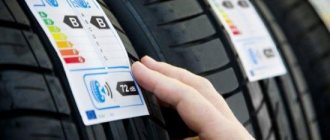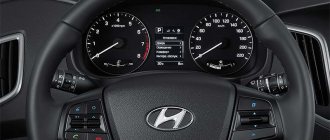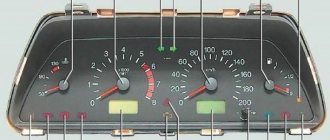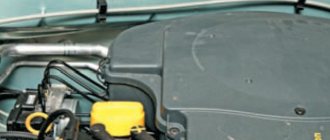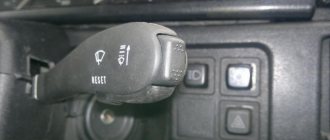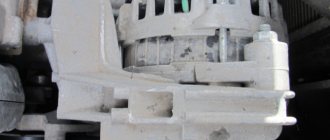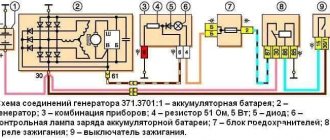Tire markings
25/07/2017
Tire markings
When purchasing or first inspecting a tire, many of the letter and number symbols are not very different from Chinese characters for most people. Most of it is service data, but there is also a lot of useful information for the buyer that will help him navigate the parameters and characteristics of the tires.
Usually, when choosing new tires, drivers first look at the size, or more precisely, the tire size. The standard designation on the side of the tire may look like a mixed set of numbers and letters:
175/70 R13 82T
— 175 — this is the width of the tire profile measured in millimeters;
— 70 is a percentage ratio: “tire profile height to tire width.” We know the width of the tire - 175 mm. The indicated figure 70 is a percentage of 175. That is, the tire height is 122.5 mm. The “series” also indicates the height of the tire profile. However, this parameter may not be present on the bus. For example, the inscription 185R14C102Q is deciphered as follows: this is a full-profile tire, whose profile height is equal to a larger value of 80-82% of the tire width.
— R — radial cord of the tire. This is a designation of the tire design characteristics when the rubberized threads on the carcass cord run parallel to each other without overlapping. Today, manufacturers often produce tires with this type of cord. Sometimes tires with diagonal cords (D) are also produced, when the rubberized threads on the frame are located at an angle to the radius of the wheel. You can also find a diagonally belted type (B).
— 13 — the value is indicated in inches and indicates the diameter of the wheel.
— 82 — coefficient or index of permissible load. Although it is considered conditional, it is still important when it comes to driving safety. This information can be seen on the bus where a pair of numbers are visible after the words Max Load. The first shows the load in kilograms, the other in pounds. The Tire Load Index section provides a complete table of the tire load ratings most commonly used by manufacturers.
— T is an important index for the further operation of tires. It shows the maximum possible speed at which the manufacturer’s warranty for all declared characteristics of the tire is maintained. A full explanation of these values can be found in the speed index section.
Individual tires have additional designations. Let's say 185R14C102Q. The letter C is a “reinforced” tire that can withstand heavy loads. Other symbols are much less common.
In addition to the dimensions, the name of the company that made the tire must be on the side of the tire. For example, Nokian and the model name, say, NRT2.
Size 175/70 R13
Dimension A: - profile and its width in millimeters. In our example, A = 175 mm.
Dimension B: - profile and its height, as a percentage of its height to its width. B = 70 percent = 122.5 mm.
Size C: - fit diameter in inches. In the example, the letter C is 13 inches. We translate and it turns out to be 330 millimeters.
Dimension D: - overall height of the tire. D is equal to 2B plus C. In our example, D = 575 millimeters.
There are other symbols with interesting and useful information:
TUBE TYPE - design with a camera.
TUBELESS - design without a camera.
TREADWEAR 380 - wear resistance in relation to the tire in the basic version. The base is 100.
TRACTION A - grip, it has values A, B and C. Coefficient A is assigned to tires with maximum tire grip on the road.
TEMPERATURE A - shows the tire’s ability to resist temperature loads. He also has the same division into A, B, C.
E17 - European standards are present.
M + S - designation of tires for rain, mud, snow seasons, driving in the rain, etc.
PLIES: TREAD - components of the tread layer
SIDEWALL - components of the tire side layer.
MAX PRESSURE - maximum pressure inside the tire (KPa).
MAX LOAD - load and maximum value, measured in pounds and kilograms.
ROTATION - rotation and its direction.
RIGHT - tire for the right side.
LEFT - tire for the left side.
INSIDE - installation side (internal).
OUTSIDE - installation side (external).
DA (stamp ) - minimal manufacturing defects that do not interfere with the declared performance of the tire.
TWI D - indicates tread wear. The indicator looks like a protrusion in the tread groove. The tire must be replaced if the tread has worn down to this indicator.
MADE IN... is the birthplace of the tire manufacturer.
DOT code is a tire marking based on the regulatory requirements of the United States Department of Transportation.
). Essentially, this code is a sequence of numbers and letters that encrypt the following bus data:
- information about the manufacturer, standard size;
- factory code (tire model, batch, any features);
- preparation time
The DOT code is always applied to the sidewall of the tire, and it looks like this: DOTХХХХ ХХХХХХХХ. For example, the tire has the designation XEE0 T255 2015
.
- The first group of numbers and letters is information about the manufacturer and size designation. In our case, this is a plant in the Brazilian city of Gravatai, where one of the Pirelli plants is located. Standard size - 185/60R15.
- The second group is an index that is used at a given plant to designate the model and batch of the tire. Some manufacturers do not provide this code.
- And the third group is data on the production date: the first two digits are the week, the second two digits are the year. This tire was released in week 20 of 2015.
Now, understanding all these designations, you can easily talk with consultants and sellers. And then, having precisely defined your goal, buy the necessary tires and you will know how long and correctly to operate these tires.
Share
What do the other letters on car tires mean?
The designations of other symbols on the side of the tire are deciphered below.
European car tire manufacturers most often use the M+S (less commonly M&S) marking. In this case, the letter “M” stands for the word “Mud,” which in English means “dirt,” and the letter “S” stands for “snow.” These letters indicate that the tires can be used in different weather conditions. In European countries, winters are not as severe as in Russia; snowfalls and ice are less common there, but in the winter season there is a lot of dirt. And the tires that our fellow citizens call winter are called arctic tires abroad.
You can also see other symbols or combinations of them on the side of the tires:
- For example, what does the letter S on tires mean? AS (All Seasons, Any Season). These tires are suitable for use at any time of the year.
- The letter combination AGT (All Grip Traction) is all-season tires.
- The letters R+W (Road + Winter) - translated means “road + winter”, that is, tires for use in the cold season.
- Frost - winter tires.
- The letters AW (Any Weather) are tires for use in any weather.
- A/T (All Terrain) - for use on any terrain.
- Letters M/T (Mud Terrain) - these tires can be used in mud.
Some tire manufacturers replace the weather rating letters with pictures. For example, if the tire has sun, raindrops or snow on it, these tires are suitable for all weather conditions. Winter tires are usually represented by a snowflake or snow-capped mountain peaks (sometimes you can see a combination of both). Among other things, on some types of winter tires, the manufacturer uses a “winter” one (4 mm thick) instead of a standard skid indicator (1.6 mm in size). Winter tires can be distinguished even by touch: their surface is much softer.
Rubber for rainy weather . There are tires designed specifically for driving a car in the rain. Such tires are usually designated by the words Aquatred, Aquacontact, Rain, Water, Aqua. Sometimes, instead of them, you can see an image of an umbrella on the side of the tire.
Purpose of the tire . Let's find out where tires can be used. Data on the functionality of the tire is located in front of the standard size:
- What does the letter T on a tire mean? (Temporary) - this tire can be used as a spare wheel.
- The letters LRO (Low Platform Trailer) are for trailers with a low platform.
- Letters ST (Special Trailer) - tires for trailers.
- The letter LT (Light Truck) is for light vans or trucks.
- The letter P (Passenger) is for passenger cars.
Production year . The year and month of its manufacture are indicated on the side of the tire. The manufacturer encrypts this information in four small numbers circled in an oval. You can also find this code on the side of the rubber. The first two digits indicate the serial number of the week (in the year), and the second ones indicate the year of production of the tire. For example, the combination of numbers 1015 means that this tire was released in 2015 in the 10th week of the year, approximately at the beginning of March.
Indexes . As a rule, three indexes are indicated on American-made tires:
- Temperature index (Temperature A, B, C) - shows the tire’s resistance to high temperatures. The best option for thermal endurance is considered to be index A.
- Braking index (Traction A, B, C) - indicates the tire’s ability to brake and its grip on the road surface on slippery and wet surfaces. The best index is index A.
- Expected mileage distance (Treadwear) - counted in numbers above 100, this mark is the starting value (100 means 48,000 km). The higher the mileage index, the better. These parameters are determined according to US standards.
Design information. Sometimes the manufacturer indicates on the tire information about the coating layers. For example, TREAD PLIES: 2 POLYESTER CORD+2 STEEL CORD+1 NYLON CORD means that the tire cover consists of 2 layers of polyester, 2 layers of metal cord and 1 layer of nylon cord.
Shipovka . What do the letters on tire markings mean? The manufacturer makes the following markings on studded tires:
- The letters MD are plastic studs with carbide cores.
- The letters OD are spikes with an oval core.
- The letters DD are studs with a rectangular core and a diamond edge.
- The letters SD are studs with a carbide core.
- The letters AD are aluminum spikes.
RSC (RunFlat System Component) - RunFlat tires are rubber on which the car cannot be driven at speeds above 80 km/h if the tire pressure is completely lost (due to a cut or puncture). On such tires you can cover from 50 to 150 km, depending on the manufacturer’s recommendations. Different manufacturers use different RSC technology markings. Here are examples: Bridgestone RFT, Continental SSR, Goodyear RunOnFlat, Nokian Run Flat, Michelin ZP, etc.
Among other things, there is a special marking indicating the absence or, conversely, the presence of different protection systems:
- The letters FB (Flat Base) indicate that the tire does not have a structural element that protects the rim from damage from curbs.
- The letters FR (Flange Protector, similar to RPB (Rim Protection Bar) or MFS (Maximum Flange Sheild)) mean that the tire has rim protection.
- The letters MFS (Maximum Flange Shield) - maximum disk protection.
We recommend
“Car clutch maintenance: procedure” Read more
Index table for maximum permissible tire load
Most often, the load index is indicated on the sidewall of the tire, but on some models, in addition to this, the maximum load “Max load” in kilograms may be indicated.
| Index | Load | Index | Load | Index | Load |
| 60 | 250 kg | 87 | 545 kg | 114 | 1180 kg |
| 61 | 257 kg | 88 | 560 kg | 115 | 1215 kg |
| 62 | 265 kg | 89 | 580 kg | 116 | 1250 kg |
| 63 | 272 kg | 90 | 600 kg | 117 | 1285 kg |
| 64 | 280 kg | 91 | 615 kg | 118 | 1320 kg |
| 65 | 290 kg | 92 | 630 kg | 119 | 1360 kg |
| 66 | 300 kg | 93 | 650 kg | 120 | 1400 kg |
| 67 | 307 kg | 94 | 670 kg | 121 | 1450 kg |
| 68 | 315 kg | 95 | 690 kg | 122 | 1500 kg |
| 69 | 325 kg | 96 | 710 kg | 123 | 1550 kg |
| 70 | 335 kg | 97 | 730 kg | 124 | 1600 kg |
| 71 | 345 kg | 98 | 750 kg | 125 | 1650 kg |
| 72 | 355 kg | 99 | 775 kg | 126 | 1700 kg |
| 73 | 365 kg | 100 | 800 kg | 127 | 1750 kg |
| 74 | 375 kg | 101 | 825 kg | 128 | 1800 kg |
| 75 | 387 kg | 102 | 850 kg | 129 | 1850 kg |
| 76 | 400 kg | 103 | 875 kg | 130 | 1900 kg |
| 77 | 412 kg | 104 | 900 kg | 131 | 1950 kg |
| 78 | 425 kg | 105 | 925 kg | 132 | 2000 kg |
| 79 | 437 kg | 106 | 950 kg | 133 | 2065 kg |
| 80 | 450 kg | 107 | 975 kg | 134 | 2125 kg |
| 81 | 462 kg | 108 | 1000 kg | 135 | 2185 kg |
| 82 | 475 kg | 109 | 1030 kg | 136 | 2245 kg |
| 83 | 487 kg | 110 | 1060 kg | 137 | 2305 kg |
| 84 | 500 kg | 111 | 1090 kg | 138 | 2365 kg |
| 85 | 515 kg | 112 | 1120 kg | 139 | 2435 kg |
| 86 | 530 kg | 113 | 1150 kg | 140 | 2500 kg |
American markings
Now consider an example of American (inch) markings:
Example: 35×12.50 R 15 LT 113R
- 35 — outer diameter of the tire, in inches
- R - the tire has a radial carcass
- 15 — tire diameter, in inches, the same as in the metric system
- LT - bus function (LT - light trucks, for light trucks)
- 113 — load index
- R - speed index
In addition to these meanings, there are also several other markings on your vehicle's tires. Let's look at them in detail.
Additional markings on car tires
When designating summer and winter tires, the manufacturer can sometimes indicate additional data about the quality and characteristics of its product.
The following markings exist:
- TUBELESS
- this marker means that the tire is tubeless. - TUBE TYPE (or TT, Mit Schlauch for rubber from Germany)
is a tire that requires the installation of a tube. - Manufacturer country
. In addition to the name of the manufacturer, the country is also written on some tires. - Marking on the outside and inside
. If the tire is asymmetrical, then on its outer side there will be the word OUTSIDE (sometimes Side Facing Out), and on the inside - INSIDE (sometimes Side Facing Inwards). - Left or Right
. In the first option, tires can only be installed on the left side of the car, in the second - only on the right. - Direction of rotation
. To do this, use the designation Rotation and an arrow that indicates the direction of rotation of the wheel when moving forward. - XL (Extra Load)
- reinforced tire. - DA or Secunda (stamp)
- these marks are placed on tires with minor defects obtained during the production process that do not affect normal operation. - Green X, Reduces CO2
- designation of rubber with a low level of rolling resistance, which helps reduce fuel consumption and exhaust emissions (so-called “green tires”). - ND (Non Directional)
- rubber with a non-directional tread pattern. - What does the H mean on NHS (Non Highway Service) tires
? These are tires for low speed driving. - SAG (Super All Grip)
- all-terrain tires. - SUV (Sport Utility VehiCles)
- tires designed for heavy all-wheel drive crossovers and sports SUVs. - REGROOVABLE
- the ability to deepen the tread pattern by cutting. - RETREAD
- tires restored after wear. - Studless
- cannot be studded. - Studdable
- subject to studding. Marking for winter tires. - Studded
- studded tires.
We recommend
“How much does a timing belt cost: choosing the best manufacturers” Read more
Tire rotation direction
If the tire has a directional tread pattern, then the direction of its rotation will be shown on such a tire in the form of an arrow with the inscription ROTATION
And if the tire has an asymmetric tread pattern, then on its inner side there will be the inscription INSIDE , and on the outer side - OUTSIDE .
Tire year
The year of manufacture of the tire is marked with four numbers. The first two digits are the week of the year (37th), the second are the year of manufacture (11).
Country of manufacture of the tire
Everything is simple here. We find the inscription “Made in...”. This tire is Chinese.
Tire speed index
This coding is intended to assign a speed category to a tire based on the results of special tests; it implies the maximum speed on the stand that the tire can withstand for several hours. Please note that during everyday use of the vehicle, it is recommended to drive at a speed 10-15% less than the maximum permissible, according to this index.
Please note that car tires marked with the speed index “ZR” are designed for use at speeds exceeding 240 km/h. The speed index can be located in different places on the marking: 185/65SR15, or 185/65SR15 92S, or 185/65R15 92S.
Tire wear indicator
The location of the wear indicator may be indicated on the side of the tire with a small inscription TWI , a triangle or some other symbol. The indicator itself usually consists of a jumper in the groove between the protectors. When the tread wears down and its height decreases to the height of the indicator, it means it's time to change the tire. There may also be a drop-shaped indicator on the tire. When this drop wears off, the tire no longer resists hydroplaning.
Winter tires have an additional indicator - a snowflake. The winter indicator is higher than the “summer” indicator, and when the tread wears down to the “winter” indicator, the resistance of winter tires to sliding on ice and snow completely disappears, and it’s time to change it. Well, or you can “roll it out” like a summer one. Some manufacturers equip their tires with a digital indicator, which appears as a number on the tire. As soon as the figure wears down to 1.6 mm for summer tires, and to 4 mm for winter tires (the minimum tread depth), it’s time to change the tires.
How to distinguish a winter tire from a summer tire?
Winter tires have M+S (Mud+Snow, Mud+Snow) on the side of the tire and a three peaks symbol with a snowflake inside. Sometimes there is no M + S sign on the tire, but there is a symbol with a snowflake - this also means. that the tire is intended for the winter season.
It is a little more difficult to distinguish a winter tire from a year-round tire. Tires of this type, found in Europe, are usually identified by a snowflake with an M+S symbol. The differences are visible in the tread. In the case of an all-season tire, it has fewer cuts and grooves than a typical winter tire, but more than a summer tire. Some models have an asymmetrical tread pattern: half is responsible for summer performance (summer tread with fewer bars), and the other for winter performance.
All-season tire model names often include phrases that indicate good performance throughout the year, such as "All Season", "Quatrac", "Quadraxer", "4 Seasons", "All Weather", etc. Some manufacturers also have your own year-round tires - these are usually symbols that allow you to easily identify the type of tire you're dealing with.
Watch out for tires that have the M+S designation without the snowflake. These may be products imported from the US, where most tires carry the M+S designation, but have nothing to do with all-season or winter products.
In European realities, all-season tires are similar to winter tires, so they most often have the symbol of a mountain with a snowflake. The M+S marking may also appear on 4x4/SUV tires regardless of their season. In conclusion, the mountain symbol with a snowflake means that the tire will perform well in typical winter conditions. UTQG marking The UTQG marking (Uniform Tire Quality Grading) applies mainly to passenger tires from the US market, but they can also be found in Europe (this model may fall into both markets). They are not officially used on our continent, so manufacturers and sellers do not report their meaning and cost for these models. This type of marking can be found on the sidewall of the tire in the form of subtitles with specific meanings: TREADWEAR - abrasion resistance of the tread, TRACTION - tire grip on wet roads, TEMPERATURE - tire resistance to overheating. tread wear.
To explain this concept well, the definition of a comparison bus should be mentioned first. This is a standardized model whose parameters correspond to the TREADWEAR 100 index. TREADWEAR values can appear on tires for sale in multiples of 20 (60 - 80 - 100 - 120 - ... 200 ... 800).
How are they distributed? The test is conducted under controlled conditions on a designated route of 6,400 miles or approximately 10,300 kilometers around Goodfellow Air Force Base, San Angelo, Texas.
The tested tires are installed on a specially prepared car together with tires with an index of 100, and then the consumption is compared. Its level is measured every 800 miles (1,287 km). Based on the measurement results, tires are given an index, such as 60, 100, 200 or 400. If a tire receives an index of 60, its theoretical durability is 60% of the comparison tire (index 100).
As a result, a tire with an index of 60 will wear out almost 2 times faster than a tire with an index of 100. In turn, a tire that receives an index of 200 will wear out 2 times slower than a comparison tire, and 2 times faster than a tire with an index of 200. index 400. A model with an index of 400 will be 4 times more durable than a comparative product (with an index of 100).
TRACTION Adhesion under UTQG marking is expressed by letters. The highest rating is AA, followed by A and B, and the lowest is C. This rating gives the driver information about the tire's ability to stop the car on wet roads.
The TRACTION parameter is determined on an asphalt or concrete path under strictly defined conditions. The test car accelerates to a speed of 65 km/h, then brakes. During the test, the vehicle's ABS system is disabled. In Europe, the lowest allowed TRACTION value is A. If someone prefers a dynamic and aggressive driving style, it is worth looking for tires with the AA index. Indices B and C are acceptable only in American conditions, and in Europe it is better not to buy such tires.
It should also be noted that the TRACTION marking does not indicate dry adhesion, flexure or hydroplaning resistance.
TEMPERATURE
The last of the UTQG designations is TEMPERATURE, which determines the tire's resistance to overheating, that is, the temperature created while driving. When driving at high speeds, the tire becomes very hot, which can shorten its life. Laboratory tests are carried out to isolate the index (possibly A, B and C, where A is the best value). Resistance to overheating is very strongly related to the speed index. Therefore, for the A mark, a 30-minute test at 115 mph (185 km/h) must be completed to obtain the B mark, at a 30-minute test speed of 100 mph (160 km/h) for both the tire and index C The tire must pass the test at 85 mph.
TRACTION (adhesion) and TEMPERATURE (overheating) markings in Europe must be at least A. TREADWEAR (wear resistance) will help you choose tires with a longer service life. If you want to take these signs into account, remember that the difference between tires with an index of 200 and 400 will be significant. However, UTQG markings should be considered as an overview only. There is no need to use them in Europe and the values are determined based on North American conditions.
Tire markings must be applied to the following tire manufacturers:
Amtel, Belshina, Barum, Bridgestone, Continental, Cooper, Cordiant, Dayton, Debica, Goodyear, Dunlop, Falken, Firestone, Fulda, General, Gislaved, Hankook, Kama, Kelly, Kleber, Kormoran, Kumho, Marshal, Matador, Maxxis, Michelin, Nitto, Nokian, Pirelli, Sava, Semperit, Tigar, Triangle, Toyo, Uniroyal, Yokohama. This tire marking is valid from 2021.


